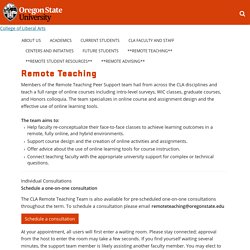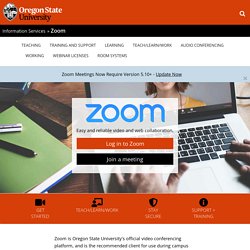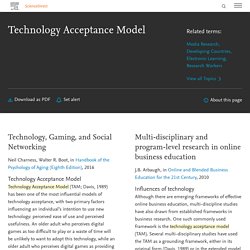

Behaviorism, Cognitivism, Constructivism: Comparing Critical Features From an Instructional Design Perspective. Why Educators Need to Know Learning Theory. This is the second in a three-part series about Learning Design. The first post introduced the Learning Design Framework; a guide for educators to create optimal learning experiences for students by leveraging: 1) content resources, 2) collaborative web resources and 3) human resources. This second post focuses on learning theory and how it applies to not only course design, but educators’ role in creating excellent learning experiences for their students. Note: this is a revised version of a post that appeared on January 19, 2014.
We need to study learning theory so we can be more effective as educators. In this post I bridge the gap between learning theory and effective educators; describe why we need to start at A to get to B. This article covers three categories of learning theories, objectivist, constructivist, and connectivist. Theories of Learning Objectivist Theories The objectivist learning category includes both the behaviorist and cognitivist theories. References. How to use these resources. Online Teaching Toolkit - Preparing for the Fall and Beyond. Oregon State University. Skip to main content OREGON STATE UNIVERSITY Open search box College of Liberal Arts Toggle menu Go to search page Remote Teaching Members of the Remote Teaching Peer Support team hail from across the CLA disciplines and teach a full range of online courses including intro-level surveys, WIC classes, graduate courses, and Honors colloquia.

The team aims to: Help faculty re-conceptualize their face-to-face classes to achieve learning outcomes in a remote, fully online, and hybrid environments. Individual Consultations Schedule a one-on-one consultation The CLA Remote Teaching Team is also available for pre-scheduled one-on-one consultations throughout the term. Schedule a consultation At your appointment, all users will first enter a waiting room. Click here to join your session Via Email The Remote Teaching Peer Support term will continue to respond to questions via email throughout 2020-2021 academic year. Email the support team CLA Remote Teaching Workshops About the Support Team Contact Info. K-12 Online Teaching Resources. Oregon State University. Zoom is Oregon State University's official video conferencing platform, and is the recommended client for use during campus closures.

Students, faculty and staff are encouraged to use Zoom to create and host high-quality online meetings, classes and events, and leverage Zoom's video, chat, breakout rooms, screen-sharing and whiteboard capabilities. Get Started with Zoom Brand new to Zoom? Check out our Getting Started guide, with installation instructions and tips for basic Zoom use. Tools: Social Bookmarking – Beyond another Paper. Social bookmarking tools help you organize and share links to articles, videos, images, websites, social media – any online content you wish to collect.

You can also share your collections with colleagues and students. This is a great way to provide students with links to resources for research and exploration. Why Use a Special Tool Instead of Posting a List of Links in a Doc? Social bookmarking tools are created for the sole purpose of helping you curate resources. They are already set up to open links in new tabs, they usually pull in site descriptions, and clearly indicate where the person who clicks on the link is heading. When you post lists or URLs in a document or LMS, you need to be sure you add alt text to the URL and specify that it open in a new tab or else your students will 1) not know what they are clicking on, and 2) find themselves off in the aethersphere far away from your course. Social Bookmarking is great for education. Characteristics of Social Bookmarking Tools. Rubric for eLearning Tool Evaluation.
OSU MediaSpace. Center for Teaching and Learning. Technology Acceptance Model - an overview. Welcome, skepticism, and concern about banking revolution in developing economies Great enthusiasm heralded the revolution of banking in developing economies.

The academia was eager to corroborate the new scientific revolution with pertinent empirical surveys. Some researchers (Chang, 2009; Sukkar and Hasan, 2005) investigated the utility in the technology acceptance model (TAM), developed by Davis (1989), in a bid to explain factors in acceptance of the innovation in Internet (online-real-time) banking. There have been other TAM-based scholarly studies on aspects of market acceptance of Internet-aided technologies (Davis et al., 1989; Davis and Venkatesh, 2000). Other researchers defined different research constructs to study aspects of electronic banking services powered by the Internet (Chang, 2007; Kivijärvi et al., 2007; Isern, 2008). Craap test. Center for Teaching and Learning. MERLOT.
EJ1064333. Educause Instructional Design. How to Conduct QM Research. Linking Online Course Design and Implementation to Learning Outcomes 2011 QM Research Grant supported study done by Swan, Bogle, Matthews, & Day at University of Illinois/Springfield The Community of Inquiry (CoI) framework (Garrison, Anderson & Archer, 2000), on the other hand, does address learning processes.

It addresses them, moreover, from a collaborative constructivist point of view. Building from the notion of social presence, the CoI framework represents online learning experiences as a function of relationships among three presences: social, teaching, and cognitive. The CoI framework views all three as working together to support deep and meaningful learning processes. In 2008, researchers working with the CoI framework developed a survey designed to measure student perceptions of each of these presences.